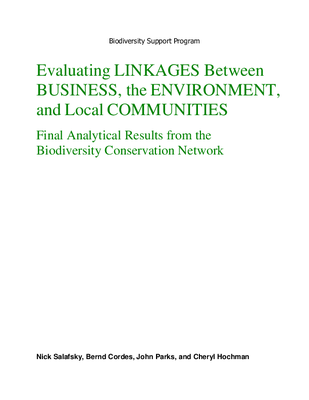Evaluating Linkages Between Business, the Environment, and Local Communities Final Analytical Results from the Biodiversity Conservation Network

Author(s): Salafsky, Nick, Cordes, Bernd, Parks, John, Hochman, Cheryl
Publication Date: 1999
Location: Asia: India, Indonesia, Nepal, Philippines. Oceania: Fiji, Papua New Guinea, Solomon Islands.
DOWNLOAD FILEThis paper presents the core analysis of linkages between business environment and the local communities. It indicates that: A) An enterprise strategy can lead to conservation but only under limited conditions; B) Adaptive management at both project and program levels is needed to determine how to optimally use an enterprise strategy. Finally it concludes that education and awareness play an important role in community participation in the enterprise with conservation.
Information relevant to Learning Questions:
Are enabling conditions in place to support a sustainable enterprise?
- Stakeholder alignment
- Market demand, profit potential
- Ownership, governance
- Government requirements, policies for enterprises, business alliances
- Financial management capacity, technical capacity
- Infrastructure
- Benefit sharing, biodiversity linkage, policies for and enforcement of resource use, external disturbance
Does the enterprise lead to benefits to stakeholders?
- Increased income for participants
- Non-cash benefits
Do the benefits lead to positive changes in attitudes and behavior?
- Not addressed
Does a change in stakeholders’ behaviors lead to a reduction to threats to biodiversity (or restoration)?
- Agriculture and aquaculture
- Biological resource use
Does a reduction in threats (or restoration) lead to conservation?
- Forest ecosystems
- Grassland ecosystems
- Marine ecosystems
- Species
Enterprise Types:
- Sustainably-harvest timber products
- Non-timber forest products: rattan, fruit, medicinal plants
- Sustainably harvested fish and shellfish
- Marine/freshwater ecotourism
- Terrestrial ecotourism
- Other natural products: handicrafts, silk, honey, butterfly farming, jams, jellies, nut oil
Document type
- Evaluation
- Case-study
- Report


